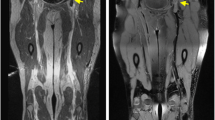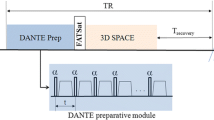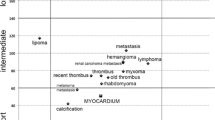Abstract
To evaluate the age of caval thrombus that experimentally induced in swine by use of magnetic resonance imaging (MRI). Caval thrombus was experimentally created in 15 swine by autologous clot injection assisted with caval net knitting. Serial high-resolution MR images were obtained using magnetic resonance venography (MRV) and T1 high-resolution isotropic volume examination (THRIVE) sequences in a 3.0-T MR system at 1, 7, 14, 21, and 28 days post model creation. At each time point, three pigs were sacrificed and the thrombotic vena cava was processed for histopathological examinations respectively. Caval thrombus was successfully induced in 15 pigs in group A. The signal intensity (SI) change of caval thrombus on THRIVE was age-dependent, with a typical sign of circle or semi-circle hyper-intensity at 7-day-old model while SI of thrombus was lower than that of muscle from day 14 throughout day 28. The histo-pathological findings revealed that RBCs-rich thrombus at day 1 without blue-stained particles, RBCs layers with infiltration of inflammatory cells and sporadically distributed blue-stained particles at 7-day-old thrombus. At day 14, 21 and 28, blue-stained particles became richer, coupled with formation of granulation tissue and fibrous tissue. The swine model in the study is good for age evaluation of venous thrombosis. The peripheral circle or semi-circle hyperintensity on THRIVE indicates the young age of caval thrombus in swine.




Similar content being viewed by others
References
Ichiki M, Sakai Y, Nango M, Nakamura K, Matsui H, Cho H et al (2012) Experimental venous thrombi: MRI characteristics with histopathological correlation. Br J Radiol 85:331–338
Goldhaber SZ, Bounameaux H (2012) Pulmonary embolism and deep vein thrombosis. Lancet 379:1835–1846
Martinez C, Cohen AT, Bamber L, Rietbrock S (2014) Epidemiology of first and recurrent venous thromboembolism: a population-based cohort study in patients without active cancer. Thromb Haemost 112:255–263
Meissner MH, Gloviczki P, Comerota AJ, Dalsing MC, Eklof BG, Gillespie DL, Lohr JM, McLafferty RB, Murad MH, Padberg F, Pappas P, Raffetto JD, Wakefield TW, Society for Vascular Surgery, American Venous Forum (2012) Early thrombus removal strategies for acute deep venous thrombosis: clinical practice guidelines of the Society for Vascular Surgery and the American Venous Forum. J Vasc Surg 55(5):1449–1462
Chen GP, Shi WY, He X et al (2017) Feasibility of continuous, catheter-directed thrombolysis using low-dose urokinase in combination with low molecular-weight heparin for acute iliofemoral venous thrombosis in patients at risk of bleeding. Exp Ther Med 13:751–758
Shi WY, Lou WS, He X et al (2015) The management of filter-related caval thrombosis complicated by heparin-induced thrombocytopenia and thrombosis. Int J Clin Exp Med 8(8):13078–13088
Shi WY, Wang LW, Wang SJ et al (2016) Combined direct and indirect CT venography (combined CTV) in detecting lower extremity deep vein thrombosis. Medicine 95(11):e3010
Abdalla G, Fawzi Matuk R, Venugopal V, Verde F, Magnuson TH, Schweitzer MA, Steele KE (2015) The diagnostic accuracy of magnetic resonance venography in the detection of deep venous thrombosis: a systematic review and meta-analysis. Clin Radiol 70:858–871
Shi WY, Wu S, Hu LY et al (2015) Swine model of thrombotic caval occlusion created by autologous thrombus injection with assistance of intra-caval net knitting. Sci Rep 5:18546
Lee YH, Hahn S, Lim D, Suh JS (2017) Articular cartilage grading of the knee: diagnostic performance of fat-suppressed 3D volume isotropic turbo spin-echo acquisition (VISTA) compared with 3D T1 high-resolution isovolumetric examination (THRIVE). Acta Radiol 58(2):190–196
Pruessm KP, Weiger M, Scheidegger MB, Boesiger P (1999) SENSE: sensitivity encoding for fast MRI. Magn Reson Med 42(5):952–962
Lee YH, Choi YR, Kim S, Song HT, Suh JS (2013) Intrinsic ligament and triangular fibrocartilage complex (TFCC) tears of the wrist: comparison of isovolumetric 3D-THRIVE sequence MR arthrography and conventional MR image at 3T. Magn Reson Imaging 31:221–226
Fujimoto M, Salamon N, Mayor F, Yuki I, Takemoto K, Vinters HV, Viñuela F (2013) Characterization of arterial thrombus composition by magnetic resonance imaging in a swine stroke model. Stroke 44:1463–1465
Jang IK, Gold HK, Ziskind AA, Fallon JT, Holt RE, Leinbach RC et al (1989) Differential sensitivity of erythrocyte-rich and platelet-rich arterial thrombi to lysis with recombinant tissue-type plasminogen activator. A possible explanation for resistance to coronary thrombolysis. Circulation 79:920–928
Saha P, Andia ME, Modarai B, Blume U, Humphries J, Patel AS, Phinikaridou A, Evans CE, Mattock K, Grover SP, Ahmad A, Lyons OT, Attia RQ, Renné T, Premaratne S, Wiethoff AJ, Botnar RM, Schaeffter T, Waltham M, Smith A (2013) Magnetic resonance T1 relaxation time of venous thrombus is determined by iron processing and predicts susceptibility to lysis. Circulation 128:729–736
Kelly J, Hunt BJ, Moody A (2003) Magnetic resonance direct thrombus imaging: a novel technique for imaging venous thromboemboli. Thromb Haemost 89:773–782
Moody AR (1997) Direct imaging of deep-vein thrombosis with magnetic resonance imaging. Lancet 350:1073
Tan M, Mol GC, van Rooden CJ, Klok FA, Westerbeek RE, del Sol AI, van de Ree MA, de Roos A, Huisman M (2014) Magnetic resonance direct thrombus imaging differentiates acute recurrent ipsilateral deep vein thrombosis from residual thrombosis. Blood 124(4):623–627
Mendichovszky IA, Priest AN, Bowden DJ, Hunter S, Joubert I, Hilborne S, Graves MJ, Baglin T, Lomas DJ (2017) Combined MR direct thrombus imaging and non-contrast magnetic resonance venography reveal the evolution of deep vein thrombosis: a feasibility study. Eur Radiol 27:2326–2332
Blume U, Orbell J, Waltham M, Smith A, Razavi R, Schaeffter T (2009) 3D T(1)-mapping for the characterization of deep vein thrombosis. MAGMA 22:375–383
Gomori JM, Grossman RI, Goldberg HI, Zimmerman RA, Bilaniuk LT (1985) Intracranial hematomas: imaging by high-field MR. Radiology 157:87–93
Usui Y, Sauvage LR, Wu HD, Goff SG, Walker M (1987) A comparative experimental study of the organization of arterial and venous thrombi. Ann Surg 205:312–317
Funding
The study was funded by the National Natural Science Foundation of China (Grant No.81873916).
Author information
Authors and Affiliations
Contributions
WS: design of study concept, drafting the MS, collecting the data and interpreting the data; YS: collecting the data, and performing the animal study; YP: collecting the data, and performing the animal study; JG: revising the MS, supervising the study.
Corresponding author
Ethics declarations
Conflict of interest
The authors declare no conflict of interests.
Ethical approval
All applicable international, national, and/or institutional guidelines for the care and use of animals were followed.
Additional information
Publisher's Note
Springer Nature remains neutral with regard to jurisdictional claims in published maps and institutional affiliations.
Rights and permissions
About this article
Cite this article
Shi, W., Shi, Y., Peng, Y. et al. Circle or semi‐circle hyper‐intensity on T1 high‐resolution isovolumetric examination (THRIVE) indicates the young age of experimentally induced caval thrombus. J Thromb Thrombolysis 52, 628–634 (2021). https://doi.org/10.1007/s11239-021-02425-3
Accepted:
Published:
Issue Date:
DOI: https://doi.org/10.1007/s11239-021-02425-3




